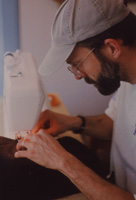
He just keeps sewing...
and sewing...
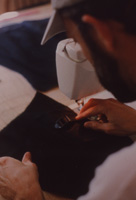
and sewing...
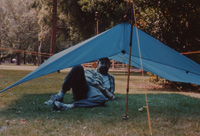
I think I'll just lie down and take
a nap here in the public park.
Maybe the cops will stop by for a
chat like they do when we are
hiking in the mornings with our
backpacks.
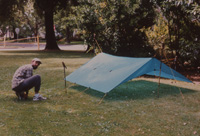
"This will sure be great once
it has mosquito netting attached,"
says Scott. "How do you suppose it
will look?"
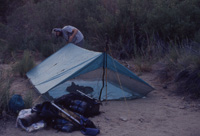
Why, exactly like this!
This is a long-winded write up of all our gear and what we liked and didn't like about it. I don't know if there's anything too helpful here except it serves as a reminder to us about how we liked certain items. Everyone has a different opinion regarding what they like. The best thing we did was to try out our gear extensively on other trips before this one.
Backpacks
In the past, we had experimented with very lightweight frameless packs and not using hip belts and were dissatisfied with the comfort of carrying these packs for long distances.
I, especially, have experienced back pain on other hikes, and was unwilling to go without a good frame sheet and hip belt. My very favorite pack is the Arc Teryx Bora 30, but it was just too small and not workable for this hike.
Arc Teryx had just come out with the Khamsin 38, so we purchased 2 (a regular and a tall) and decided to modify them. The packs started at 2750 and 3050 cubic inches and weighed between 2-3 pounds. Scott disassembled the packs, retaining the shoulder straps, hip belts, and backs with the frame sheets. He replaced all the nylon with lighter-weight 1.9 oz. nylon and added 1000 cubic inches of space to each pack as well as sewed netting to the outside of the pack to allow us to carry things on the outside and used 300 d. cordura on the bottoms. When finished, the packs weighed only 2 pounds and were very comfortable and worked great the entire way.
The only problem I experienced is that my hip belt became too small as I lost a lot of weight. I should have ordered a smaller hip belt so I could have swapped a smaller one. (the pack had a removable hip belt, so this would have been simple.)
Tent
We used hybrid design of both Henry Shires' and Ray Jardine's tarp tents. The tent and ground cloth together weighed about 2.5 pounds. (See picture) We liked our tarp tent and found that it worked well in high wind and rain situations that we encountered. It had plenty of room for the two of us plus gear, plenty of ventilation. I don't know how it would have been in extensive rainy situations in Washington, however. Note about the ground cloth-it would have been nice to have 2 pieces of ground cloth so if the area isn't wide enough (or you just want to get away from your partner-whichever comes first) you can each have a piece. We also wished that we could have replaced our piece of Tyvek. It got really dirty and worn and embedded with stickers after about 6 weeks, but it always worked well.
Shoes
Both of us used trail-type running shoes. We both started the trip wearing Asics Nandis. Scott had broken in a pair of Merrill Red Deserts and used those when the Nandis wore out. I stuck with the Nandis. (We both tried the New Balance 803's and didn't like them, but lots of people do.)
In retrospect, I think that I would have used a light-weight hiking boot in the Sierras. I find that I twist my ankles more often than other people and probably would have benefited from this. As with everything else, what works the best varies from person to person. Scott was happy with his shoes. I also found that the Nandis had a weak spot on the ball of the foot (a gel area) that broke down and caused me to feel sharp rocks, etc. after I had worn the shoe for quite some time. I should have replaced them more often than I did.
Water
We always carried a water filter. We did not use iodine tablets because Scott has a thyroid condition. There were many places along the trail where water was unclean, just puddles, or in one case rust colored, so a filter made us feel much better, and it's more palatable to drink water that is actually clear. Hiking in the late season, we found more questionable water sources than people probably find earlier in the season, and somtimes were pumping from puddles or barely running springs so we were glad to have it. Everyone, however, has their own comfort level.
We also carried a 1-quart Platypus bag so that we could constantly sip water when we wanted. The rest of the water was carried in plastic water bottles. (On previous hikes we had carried 3-quart Platypus bags but didn't like this because it's hard to keep tabs on how much you've drunk.)
Umbrellas
Scott made us two of the Jardine Mylar umbrellas that we carried with us strapped to the back of our packs. These came in handy on very hot days. I found, however, as I became more adjusted to the heat, that I preferred to hike with both my poles and just wear a big hat unless it was really really hot. Scott did not mind hiking while holding the umbrella. We were glad we had the umbrellas on a few occasions.
Gators We both wore low gaters that kept dirt and pebble out of our shoes and stickers out of our socks. They kept our feet a lot cleaner too, which is an added bonus when you are trying to tend to blisters. They were one of the best pieces of equipment we had. I had a lot of trouble snapping and unsnapping my gators, however, and on one pair, the snap actually broke. Also, later in the hike, I had trouble keeping them up. I think my calves got smaller or something. Even a new pair didn't help. We were using the REI ones. There may be some better ones out there. Hopefully.
Hiking Poles
We used the "Leki Super Makalu Cor-Tec Positive Angle Trekking Poles" (say that 5 times fast). We love hiking poles. I have had trouble with a knee off and on when I backpack and since I started using the poles, three years ago, I've had no problems. They came in handy again and again. They were great for keeping my balance during stream crossings too. (Definitely carry extra tips.)
Pocketmail and Keeping a Journal
Keeping a journal was one of the best things we did. Not only does it help us remember the trip, but keeping an interactive journal like the one we kept by using Pocketmail really helped our morale. (mine especially) We sent and picked up emails at every re-supply stop that we could. Friends back home sending messages and laughing over our tough times and cheering over our progress made me want to keep going and keep telling the story. I wanted to find out how I was going to handle the challenges too. What would tomorrow bring? Writing about the experience at the end of the day helped me handle hard situations with humor. I'd be walking along and it would be a hard section and I'd compose renditions of my next journal section in my head.
Stove Stuff
We carried fuel tabs which were very light and worked very well. We used those REI storm-proof matches and never had trouble lighting them when using those matches. We also weren't bothered by the only-one cooking speed. We only cooked one meal a day and used the ever-popular one-pot-two-spoon method. In retrospect, not having a stove at all probably would have been fine too. Sometimes cooking was a pain.
Ice Axes
We carried the Gravel Air Tec ice axes. We used them in ice axe training and liked them. We didn't ever need them on the trip though, so not a lot of notes on these.
Clothes
We wore the same hiking outfit every day (short and shirt). We also carried a fleece jacket, windbreaker and wind pants, extra bandana, and extra socks, and (me-even in So Cal) very light long underwear bottoms. I also carried an extra shirt to sleep in, because I couldn't stand the stench of my shirt. Scott toughed it out. In the Sierras, we started carrying a full set of long underwear as well as well as a waterproof shell and mittens. I really liked my long sleeved Rail Riders shirt too. It offered a lot of protection from the sun which I need and it dried fast too.
Sleeping Gear
Our warmer weather sleeping bags were the feathered friends 1- pound-40-degree models. Our cold weather sleeping bags were the 2-pound-20-degree models, and were well worth the extra weight. In So Cal I didn't like the 3/4 inch zipper. We also each carried a ¾ length Therma-rest pad. While not the lightest pad out there, we knew from experience that it helped us get a better night's sleep. (I can't stand those Z-Rests. (I needed to say that) ) Some things are just worth the extra weight. We also used sleeping bag liners which kept the bags cleaner and added a little extra warmth.
Cell Phone
We decided to carry a 4 oz. cell phone that came in handy on a few occasions. We only used it about 3 times, but it was really convenient when we needed it.